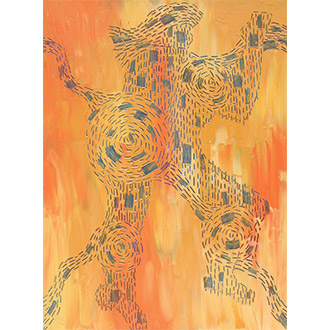Mentor/Mentee Relationships Subject of Exhibition
By Robin Davis, Staff Writer

The image of the artist as a fierce individualist working independently of any establishment is a fairly recent concept. Throughout the Middle Ages, in Europe art was a trade with strict standards dictated by tradition. Promising young students joined professional artists’ studios as apprentices. They received instruction and were often put to work on commissions from the Catholic church or other wealthy patrons. This training was rigorous and codified; changes in style were born of artists expanding on norms and pushing the boundaries of what they were taught. In the 18th and much of the 19th centuries, successful artists were those that had been trained in traditional academies. Art’s position in society has of course changed considerably since then. With the modern expansion of creative practice and its philosophical framework, relationships within the art world also evolved. Art schools became places not only to be taught, but to experiment. Teachers were no longer meant to be copied, but acted as critics and guides.
A teacher whose goal is to draw out and strengthen a student’s unique talent also acts as a mentor. This relationship goes beyond simple instruction. The mentor helps their mentee mature as a confident practitioner who understands how to live as an artist, taking what they’ve learned out of the classroom and integrating it into their lives after they graduate. The specific ways that a mentor can influence a young artist’s development inspired Amy Rahn, Assistant Professor of Art History at the University of Maine at Augusta and director of the Charles Danforth Gallery, to stage Generations: University of Maine Artists Choose Artists. She invited art teachers from the University of Maine system to participate by choosing one of their former students to exhibit works alongside them. As Rahn explains in the exhibition catalog, “seeing the works of art faculty beside their former students highlights and celebrates the ways art faculty…mentor and support artistic growth in the studio and beyond.” She goes on to note that the exhibition is meant to bring attention to not only the impact of the mentor/mentee dynamic in the lives of young artists, but also the way that learning in a studio setting fosters growth. “The studio is a generator,” according to Rahn, “and the artists that feed its engine as teachers and the artists that draw on its energy and forge new visions as learners know it as a warm place where art and artists grow.”
Hannah Barnes, USM’s Art Department Chair and an Associate Professor of Art, chose Ali Dion as her featured former student. Barnes describes Dion, who completed her BFA in Studio Arts with a concentration in Painting and Drawing in 2023, as someone who “models the qualities of an individual determined to make their way as an artist.” Helping each student find their own voice–in addition to giving them constructive training–forms the basis of Barnes’ approach to teaching: “Cultivating…confidence and self-awareness is key to creative mentorship.”
One of the most important lessons that Dion says she learned from Barnes is to persist in creating even when a project is complete. If she finished an assignment early, Barnes would encourage Dion to start on another canvas, believing that creativity is fostered through constant practice. As is often the case, Barnes finds that learning is reciprocal. “It’s a cliche, but it’s true!” she says. “I learn more from my students than they will ever learn from me.”
Both artists use abstraction in their work, and their mutual love of color and shape is readily apparent. The pieces that Barnes exhibited in Generations are geometric and patterned, their precision of line bringing to mind textiles or stained glass. This emphasis on structure, shape, and repetition reflects her interest in approaching art as “ritual labor” and a process-based practice.
Dion’s series of works appears to take a more spontaneous approach to abstraction due to her textured brushwork. She layers the paint and then removes it in certain areas; this process of scraping away is Dion’s “physical way of abstracting” her paintings. Although she uses abstraction as a means to gesture towards a specific subject, her work, like Barnes’, speaks to the concept of painting as process. This becomes especially apparent when looking at her works in Generations. The five pieces were inspired by the chemical structure of melatonin and her experience with insomnia. Thus, the works are joined not only by a subjective thread but a formal one which is seen in the progressive ways that she uses repeated patterns and shapes.
Reflecting on the type of relationships that the exhibition bears witness to, Dion asserts that “community is what brings art to life.” The way that the art community works together to support artists and their work has changed over time, yet the importance of connecting with fellow artists in different stages of their creative development has not.
Generations: University of Maine Artists is on display at the Charles Danforth Gallery now until October 18.

